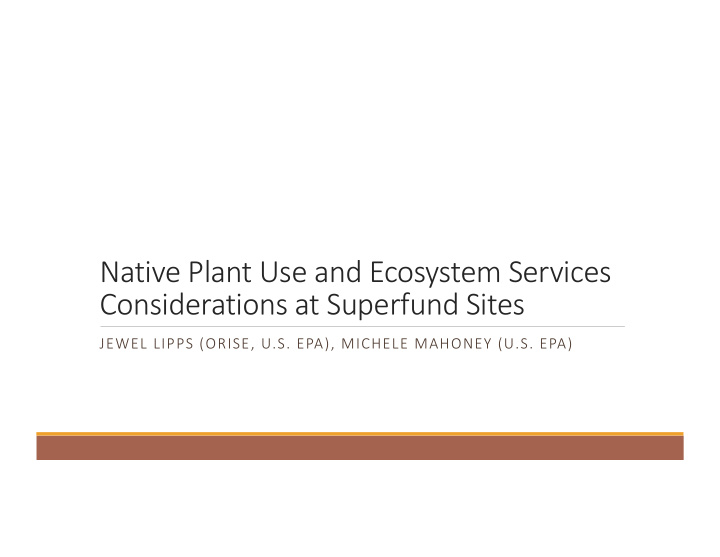



Native Plant Use and Ecosystem Services Considerations at Superfund Sites JEWEL LIPPS (ORISE, U.S. EPA), MICHELE MAHONEY (U.S. EPA)
Cleanup contaminated sites What is • Reduce risks to human health and the environment from chemicals and hazardous Superfund? waste (lead, organic pollutants) United States federal government program established as the Revitalization and reuse opportunity Comprehensive Environmental Response, Compensation, and Liability Act of 1980 (CERCLA). • NOT an ecological restoration program • Cleanup often involves large-scale revegetation for erosion control, waste cover, etc.
Pollinator Health Task Force (2014) Ecosystem Examples of Services Greener (2015) Relevant Cleanups Superfund (2016) Cleanups Policies and National Initiatives Invasive Species Council (1999) Future Land Use (2010)
Ecological Reuse 81 Superfund Sites in 2011 (map on the right) 127 Superfund Sites in 2017
Revegetation in Site Remediation Vegetative Cap at Soil Amendments at Evapotranspiration Bayou Verdine, LA Bunker Hill, ID Cover at Onondaga Lake, NY 5
Revegetation in Site Reuse Pollinator Prairie Garden Lehigh Gap Nature Recreational Fishing at at former Chemical Center at Palmerton California Gulch, CO Commodities Inc., KS Zinc, PA
Palmerton Zinc, PA https://clu-in.org/ecotools/NARPM2011_EPA_Reuse_new-1.mp4
Case Study: Palmerton Zinc Before (2002) After (2003) https://clu-in.org/download/issues/ecotools/PalmertonZincCaseStudy-2-2011.pdf
Case Study: Bunker Hill Before (1993) After (2003) https://clu-in.org/ecotools/downloads/bunker_hill_eco_case_study_final_feb2015.pdf
Future Evaluation of Ecosystem Services at Superfund Cleanups Directions: Ecosystem Services Quantification Tools Best Practices Tools Ecosystem services are the benefits people receive from nature. • EPA EnviroAtlas • ASTM Standard Guide for There is an ongoing research effort to Greener Cleanups • i-Tree Suite promote evaluation of ecosystem • CLU-IN.org EcoTools • EPA Rapid Benefit Indicators services at contaminated sites. Approach Toolkit • NatiVeg • ESII Tool • Pollinator Partnership Ecoregional Planting Guides • Habitat Assessment
Ecosystem Services Evaluation Framework for Greener Cleanups and Ecological Reuse Examine Outcome: Identify Quantify Identify & eco services protect and Implement site-specific eco relevant eco affected by revitalize eco services services best practices remedy services 11
Simplified, Hypothetical Example Ecosystem Services Quantitative Indicator or Affected by Example Best Practices Measurement Remediation Flood Risk Reduction Gallons per year Yes Incorporate Green Infrastructure Pollination Regional Pollinator Species Yes Establish pollinator habitat Richness as landfill aps Air Pollution Removal Tons of air pollutants per year Yes Minimize clearing of trees and other vegetation Bird Watching Regional Bird Species Richness Yes Ongoing invasive plant species management Environmental Education Number of Students within Yes Revegetate with plant Travel Distance to the Site species of the regional ecosystem 12
Need for Seeds The ecosystem services concept and evaluation will be another opportunity to promote revegetation with native plants at sites. Superfund site teams will need: • Technical expertise and partnerships • Seeds! ◦ Where to get large quantities of native seeds? ◦ Quality of seeds? ◦ Diverse mix of seeds? ◦ Cost of seeds?
Contact Information Michele Mahoney, Environmental Scientist Mahoney.Michele@epa.gov Jewel Lipps, ORISE Research Participant Lipps.Jewel@epa.gov Photos, videos, and case studies for sites can be found at https://clu-in.org/ecotools/default.cfm
The preceding presentation was delivered at the 2017 National Native Seed Conference Washington, D.C. February 13-16, 2017 This and additional presentations available at http://nativeseed.info
Recommend
More recommend